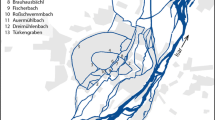Abstract
The first water problem imposed by the urbanization of the Chicago metropolitan area was drainage. Early Chicago was a flat, marshy plain. Development required dry land, and this was produced primarily by draining. As Chicago grew, its prime water supply, Lake Michigan, was polluted by the wastes of its population. To protect the lake, the flows of the Chicago and Calumet rivers were reversed by a system of canals. Federal court limitations on the use of this canal system and accelerated urbanization in the 1920s led to Chicago's early adoption of sewage treatment. Today's water pollution and flooding problems have resulted in the mammoth Tunnel and Reservoir Project, one of the largest urban water resource construction projects in the world.
Similar content being viewed by others
References
Cain, L.P.: Sanitation strategy for a lake front metropolis — The case of Chicago. Northern Illinois University Press, DeKalb, IL 1978
Thurder, I.D.: The Illinois and Michigan Canal. Illinois Section ASCE News 17, 7 (1976)
US Army Corps of Engineers: Preliminary environmental assessment. Proposed increased Lake Michigan diversion at Chicago demonstration program. USACE Detroit District 1979.
Author information
Authors and Affiliations
Rights and permissions
About this article
Cite this article
Macaitis, W. Chicago's water problems and solutions. GeoJournal 11, 229–237 (1985). https://doi.org/10.1007/BF00186336
Issue Date:
DOI: https://doi.org/10.1007/BF00186336




